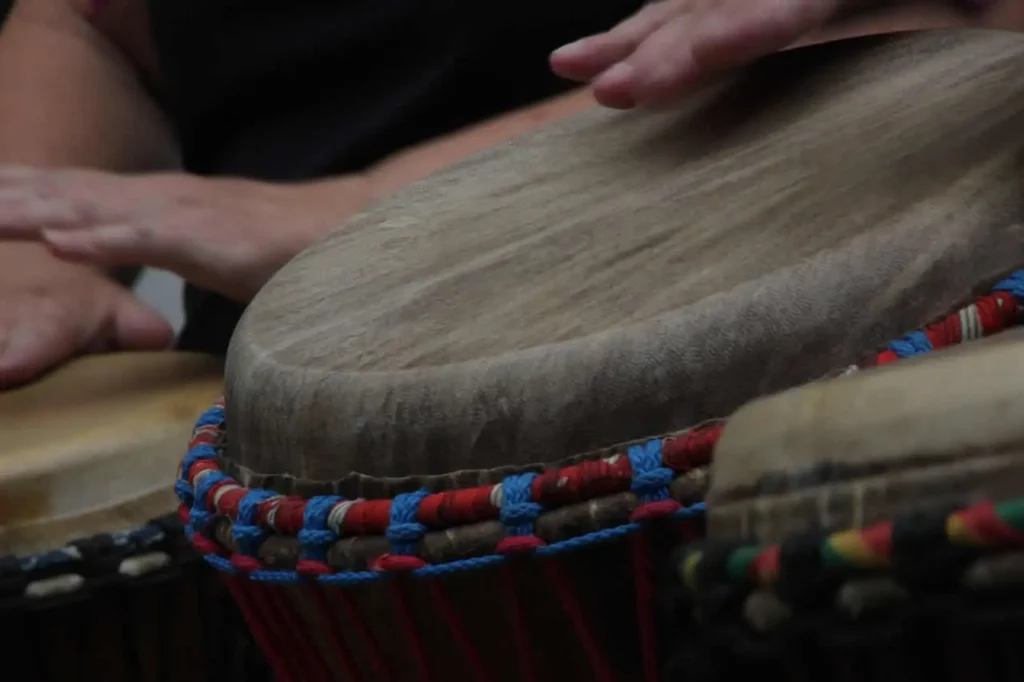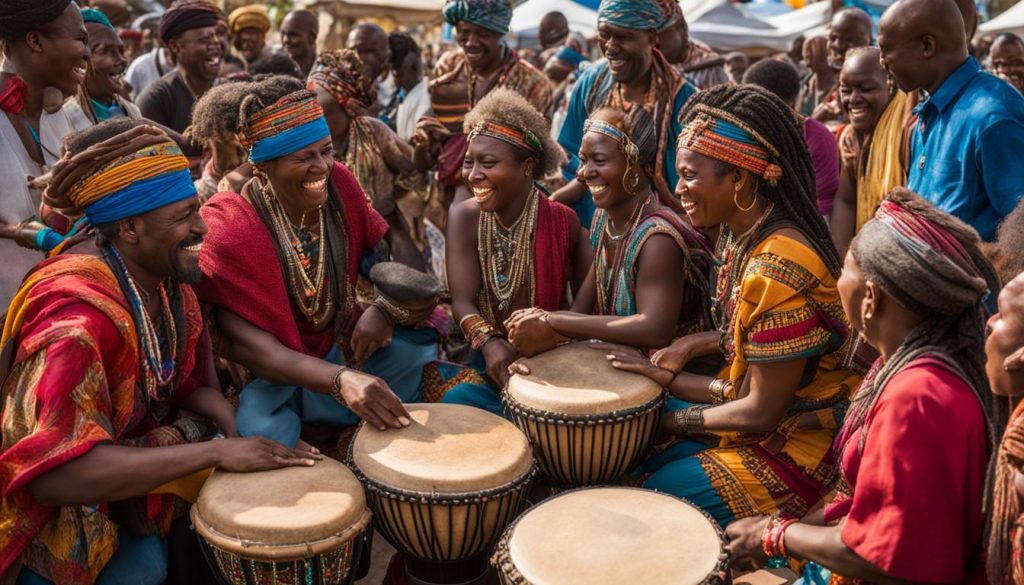Welcome to our article on African Djembe drum facts! If you’ve ever been captivated by the rhythmic beats of the djembe drum or want to learn more about this fascinating instrument, you’ve come to the right place.
Whether you’re a music enthusiast, a history buff, or simply curious about different cultures, this article will provide you with valuable insights into the world of the djembe drum and its enduring impact.

Content
The Facts of African Djembe Drums
But first, let’s start with the basics. The djembe is a goblet-shaped drum traditionally carved from a single piece of African hardwood and topped with an animal skin drumhead.
It belongs to the percussion family and is most commonly associated with West Africa. The name “djembe” originated from the Bamana people in Mali, who used the phrase “Anke dje, anke be” to call people together.
With a history dating back 400-800 years, the djembe holds a significant place in African culture and spirituality.
Playing the djembe is not just about drumming but about channeling the spirit of the instrument and connecting with the music and the community. It serves as a tool for communication between tribes and communities, allowing messages to be conveyed over long distances.
Additionally, the djembe drum plays a central role in various West African rituals, ceremonies, and celebrations. It is considered a sacred instrument, believed to connect the physical and spiritual realms.
Join us as we dive deeper into the importance of the African djembe drum, its role in West African rituals, its communication capabilities, and its influence on global music.
Discover why this iconic instrument continues to inspire and captivate people across the world.
Importance of the African Djembe Drum
The African djembe drum holds great significance in the cultural and ritualistic life of West Africa. It is a symbol of African heritage and tradition, representing unity and identity within communities.
The drum is not just a musical instrument, but a powerful tool used in ceremonies, celebrations, and mourning rituals.
It plays a pivotal role in everyday activities like planting and harvesting, as well as serving as a means of communication between tribes and villages.
The djembe drum is deeply rooted in the fabric of West African culture. Certain families and castes are responsible for playing the djembe in their respective villages, carrying on the traditions associated with it.
This further strengthens the bond among community members and fosters a sense of shared identity.
The djembe drum’s importance goes beyond its physical presence. It serves as a vessel for spiritual connection and expression.
The rhythms and beats produced by the drum are believed to carry messages to ancestral spirits and invoke their presence during rituals.
Playing the djembe is a means of channeling the spirit of the instrument and connecting with the music and the community.
Furthermore, the djembe drum holds historical and cultural significance. It has served as a tool for communication between tribes for centuries, allowing messages to be conveyed over long distances.
The drum’s rhythms could imitate spoken phrases, conveying meanings and transmitting information. This aspect of the djembe drum highlights its role as a cultural bridge, fostering connections and fostering a sense of community.
Overall, the African djembe drum is a symbol of cultural heritage, tradition, and unity. It holds immense importance in the cultural and ritualistic life of West Africa, serving as a tool for communication, expression, and celebration.
Its rhythms resonate deeply within communities, connecting people to their roots and ancestors.
The Role of the Djembe Drum in West African Rituals
The djembe drum holds a central position in the spiritual and ritualistic life of West Africa. It plays an essential role in various ceremonies, including baptisms, weddings, and funerals.
The drum is believed to possess a profound connection with both the physical and spiritual realms, acting as a vessel that brings the spirit of the drum to life.
During these rituals, the djembe sets the rhythm and serves as the foundation for other instruments and vocalists. Its powerful beats resonate with the music and dance, enabling individuals to connect with their ancestors and invoke their presence.
The djembe drum holds a sacred status and is treated with utmost respect and reverence by the communities that incorporate it in their rituals.
The Significance of the Djembe Drum in West African Rituals:
| Ritual | Description |
|---|---|
| Ceremonies | The djembe drum accompanies various traditional ceremonies, bringing a sense of unity and spirituality to the event. |
| Baptisms | During baptism rituals, the djembe drum signifies purification and rebirth, creating a sacred atmosphere for the ceremony. |
| Weddings | The djembe drum symbolizes joy, love, and the blending of two families during wedding ceremonies, intensifying the celebratory spirit. |
| Funerals | In mourning rituals, the djembe drum expresses grief and allows individuals to honor and remember the departed. |
Overall, the djembe drum holds tremendous significance in West African rituals, elevating the spiritual and emotional aspects of these events.
Its rhythmic beats and sacred status contribute to the rich cultural heritage and traditional practices of the region.
Communication and the Djembe Drum
The djembe drum goes beyond its role as a musical instrument in West Africa, serving as a powerful means of communication between tribes and communities.
Through the rhythmic patterns and beats produced by the djembe, messages can be conveyed, making it a unique form of language. In the past, the djembe was utilized to transmit information, signal danger, announce events, and even gather people together.
The intricate rhythms were designed to imitate spoken phrases, enabling messages to be carried over long distances, and ensuring effective communication across the region.
Today, the djembe drum continues to play a significant role in communication, both within African communities and in the global music scene.
Its ability to convey meaning through rhythm and beat allows musicians to express themselves and connect with audiences on a deeper level.
The djembe’s versatility and expressive capabilities make it an ideal instrument for artists to bridge cultural gaps and foster understanding through music.
Furthermore, its integration into various musical genres worldwide highlights the drum’s enduring influence and its ability to transcend cultural boundaries.
Communication Features of the Djembe Drum:
- Transmits messages between tribes and communities
- Signals danger and announces events
- Gathers people together
- Rhythmic patterns imitate spoken phrases
- Enhances communication within African communities
- Facilitates cross-cultural exchange in the global music scene

Comparing Djembe Drum Communication with Verbal Communication
| Aspect | Djembe Drum Communication | Verbal Communication |
|---|---|---|
| Distance | Can be used over long distances | Restricted by the range of the human voice |
| Universal Understanding | Rhythm can be understood by various cultures | Language barriers can limit comprehension |
| Emotional Expressiveness | Drumming can convey powerful emotions | Words may not fully capture emotions |
| Community Bonding | Strengthens bonds within tribes and communities | Eases social interactions and fosters connections |
Celebrating and Mourning with the Djembe Drum
The djembe drum holds a special place in the hearts of West African communities, as it is used to commemorate and honor both joyful celebrations and solemn occasions.
Its powerful beats have the ability to inspire a range of emotions, from pure celebration to deep reflection.
During weddings, the djembe drum takes center stage, providing a rhythmic backdrop that sets the tone for dancing and singing.
The lively and energetic beats resonate with the joyous atmosphere, creating a festive ambiance that fills the air with excitement and happiness.
Birth ceremonies are also accompanied by the rhythmic sounds of the djembe drum. Its pulsating beats symbolize the joy and anticipation of welcoming a new life into the world.
The drumming serves as a unifying force, bringing together family and friends to celebrate the miracle of life.
While the djembe drum is synonymous with celebration, it also plays a significant role in mourning rituals.
When communities come together to mourn the loss of a loved one, the djembe provides a means of expressing grief and honoring the departed. The solemn beats of the drum echo the collective sorrow, creating an atmosphere of reflection and remembrance.
Whether in celebration or in mourning, the djembe drum has the power to inspire and uplift. It serves as a reminder of the strength of the human spirit and the importance of coming together as a community in times of both joy and sorrow.
Explore the versatile rhythms of the djembe drum in the table below, highlighting its role in celebrations and mourning:
| Occasion | Significance |
|---|---|
| Weddings | Provides a rhythmic backdrop for dancing and singing, symbolizing joy and unity. |
| Birth Ceremonies | Celebrates the arrival of a new life, creating a joyful and vibrant atmosphere. |
| Mourning Rituals | Expresses grief and honor for the departed, providing a space for reflection and remembrance. |
The Evolution and Global Influence of the Djembe Drum
The djembe drum has undergone significant evolution over the years, adapting to changing cultural and musical contexts.
Traditionally, the drum was mainly played by individuals born into the djembe family, with specific castes and lineages responsible for carrying on the tradition.
However, with the widespread popularity of West African music and the influence of globalization, the djembe has gained a new following worldwide.
Today, the djembe is played by musicians hailing from different backgrounds and cultures, showcasing its ability to transcend boundaries and connect people through music.
Its versatile rhythms have been incorporated into various genres, including jazz, fusion, and world music, extending its influence beyond traditional African contexts.
The global popularity of the djembe has played a pivotal role in raising awareness of African music and culture.
It has become a symbol of unity and cross-cultural exchange, inspiring individuals to explore traditional drumming techniques and rhythms.
The djembe’s distinctive sound and powerful presence have captivated audiences around the globe, making it a prominent instrument in both traditional and contemporary music scenes.
To better understand the evolution and global influence of the djembe drum, let’s take a look at the following table showcasing the key milestones throughout its journey:
As the table illustrates, the djembe drum has experienced a remarkable transformation, from its origins as a traditional African instrument to its current status as a global musical icon.
Its evolution has not only enriched the cultural heritage of West Africa but has also fostered cultural exchange and appreciation worldwide.
The Djembe Drum Today
Today, the djembe drum holds a prominent position as one of West Africa’s most revered and iconic instruments.
Its rhythmic beats can be heard in traditional ceremonies, cultural events, and contemporary music settings alike.
This versatile instrument has transcended boundaries and captivated people from around the world with its powerful and spirited sound.
While there are ongoing debates surrounding the authenticity and quality of modern djembe drums, a dedicated movement has emerged to preserve the traditional craftsmanship and cultural significance of this instrument.
Artisans and master drummers strive to maintain the integrity of the djembe by utilizing age-old techniques and selecting high-quality materials, ensuring that its resonance resonates with both the past and the present.
Passing on the knowledge and legacy of the djembe is paramount in keeping this instrument’s spirit alive.
Various master drummers and teachers are committed to sharing the rhythms and traditions associated with the djembe.
They serve as custodians and ambassadors, investing their expertise and passion to ensure that the djembe drum remains an integral part of West African culture and music, captivating generations to come.
